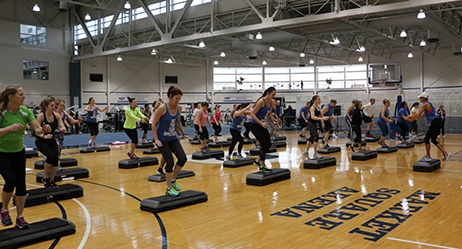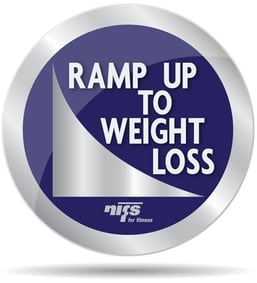Whether you are 18 or 80, man or woman, looking to lose weight or simply maintain, step aerobics just might be the perfect addition to your fitness program! Have you ever considered taking a step class? Perhaps you have found yourself thinking, “I’m not coordinated enough,” or “Step is too intense for me (or not intense enough”). Well, give me two minutes to change your mind.
Step Burns Calories
The bottom line is, stepping up and down off a raised platform burns calories. In fact, it burns A LOT of calories. According to Self Magazine (July 2012, page 101), stepping up and down off a raised platform burns more calories than doing jumping jacks, split lunges, power squats, or speed skating for the same length of time. Great way to lose weight? YES! Great way to maintain weight? YOU BET!
Anyone Can Do Step
Maybe you are thinking that you lack the coordination required to do step. But the reality of it is, if you can march in place, you can do step. The basic step is just that: basic. Up, up, down, down. Of course that move would get pretty boring pretty quickly, so we add music, rhythm, and variations on that basic move. While it helps to have a little rhythm (can you clap your hands to the beat of a song?), anyone can step. It may take a few classes to really get the hang of it, but it is quite do-able, and FUN! Don’t be intimidated!
There is a first time for everything. At some point, every single person in the class, including the instructor, attended their very first step class. I am not gonna lie, you probably won’t pick up every single thing the first class you take. But let’s face it: What would be the fun of mastering it in the first hour? Half the fun is seeing yourself improve on the step, seeing your cardiovascular fitness level improve, and becoming more efficient overall (doing more work with less effort). Step will get you there!
You Can Adjust the Intensity Level
You may be thinking that step would be too hard or too intense for you. While step is designed to be a challenging cardio workout, the intensity level can be adjusted in a number of ways to meet the needs of each participant. The height of the platform is not uniform; with use of individual risers at each end, the platform can be set as low as just a few inches off the floor (or as high as 8 to 12 inches).
Another easy adjustment, which your instructor will show you, is to limit your range of movement with each step. As you become more comfortable with the format, you will be able to add intensity by increasing range of motion with the steps, and by adding arm movements to further increase your heart rate. Because of this, the challenge never ends. There is no plateau.
Step Can Be a Challenging Cardio Workout
On the flip side, maybe you are thinking step is not intense enough. Perhaps you are thinking that only girls take step, or that you are too fit to benefit from it. Regardless of your fitness level, step can be a very challenging cardiovascular workout. It is a well-known fact that the U.S. military utilizes step aerobics to improve our troops’ agility, coordination, and endurance. If it’s tough enough for our soldiers, then it’s tough enough for me! In addition to step, I also teach Insanity, total body conditioning, and kickboxing classes. Step meets or exceeds these other formats in intensity level and calories burned per hour.
Step Is Great for Group Fitness
Step is the perfect group fitness exercise because it accommodates all fitness levels. And if you haven’t tried group fitness, well that’s a whole other conversation. But in short, try it! The camaraderie and accountability among the participants, the music, and the FUN factor will have
you hooked!
So, are you ready to take your fitness regimen to the next STEP? Click her for a free class pass to NIFS!
This blog was written by Rachel Pfeiffer, ACE and AFAA Certified Group Fitness Instructor Insanity Certified Instructor; Proud NIFS Step Instructor since 1999


 Losing weight can be one of the most frustrating things to work at. We all know someone who has gone through it or may have experienced ourselves the constant ups and downs and carrying the heavy burden that goes along with it.
Losing weight can be one of the most frustrating things to work at. We all know someone who has gone through it or may have experienced ourselves the constant ups and downs and carrying the heavy burden that goes along with it. 

 The More You Move, the Healthier You Can Be
The More You Move, the Healthier You Can Be Of the many lessons that the recent events have provided, one that stands out to me is that anybody can be anything if they take action and pursue it.
Of the many lessons that the recent events have provided, one that stands out to me is that anybody can be anything if they take action and pursue it.  You’ve seen it on the news and read articles in magazines, but is it really true? Can chocolate actually be good for you? Isn’t it too delicious and forbidden to be a food that can help with heart disease? Of course nutrition is confusing and things change all the time about what is good and isn’t so good for you, so what is the deal with chocolate?
You’ve seen it on the news and read articles in magazines, but is it really true? Can chocolate actually be good for you? Isn’t it too delicious and forbidden to be a food that can help with heart disease? Of course nutrition is confusing and things change all the time about what is good and isn’t so good for you, so what is the deal with chocolate?  Cocoa naturally has a very strong taste, so it has to go through many steps to form your favorite type of chocolate. And through this processing many of the flavanols are lost. Most commercial chocolates are highly processed, and therefore have the lowest amount of antioxidants. However, dark chocolate that has undergone minimal processing will have the highest amount of flavonoids. As far as cocoa goes, the best choice is one that hasn’t undergone Dutch processing, which is when they treat it with an alkali to neutralize the natural acidity. (For more about how chocolate is created and how to enjoy it, check out
Cocoa naturally has a very strong taste, so it has to go through many steps to form your favorite type of chocolate. And through this processing many of the flavanols are lost. Most commercial chocolates are highly processed, and therefore have the lowest amount of antioxidants. However, dark chocolate that has undergone minimal processing will have the highest amount of flavonoids. As far as cocoa goes, the best choice is one that hasn’t undergone Dutch processing, which is when they treat it with an alkali to neutralize the natural acidity. (For more about how chocolate is created and how to enjoy it, check out  Step aerobics has been around for some time. We are all aware of its huge popularity in the 80’s, and while some may have thought it was dead and gone, many know it is alive and kicking! With the launch of
Step aerobics has been around for some time. We are all aware of its huge popularity in the 80’s, and while some may have thought it was dead and gone, many know it is alive and kicking! With the launch of  If you take a few minutes to google the various types of fitness training out there, you will come up with a list of about 10 different ones, and then 10 more different variations of each of those. And each year more and more “fitness trends” come out, making it quite confusing for the consumer as to what to choose and where to start. It can be confusing and even frustrating choosing what is right for you and your body.
If you take a few minutes to google the various types of fitness training out there, you will come up with a list of about 10 different ones, and then 10 more different variations of each of those. And each year more and more “fitness trends” come out, making it quite confusing for the consumer as to what to choose and where to start. It can be confusing and even frustrating choosing what is right for you and your body.  This type of training is specific to each individual and their personal zones. You can read more
This type of training is specific to each individual and their personal zones. You can read more  Strength training typically is done with heavy weight but can be done with lighter ones as well. This style of training is directly associated with Newton’s law: mass x acceleration = force.
Strength training typically is done with heavy weight but can be done with lighter ones as well. This style of training is directly associated with Newton’s law: mass x acceleration = force. 
 As the new year is here, we start forming new goals for the next. I would like to share a story of a member who has worked incredibly hard through 2015 and 2016, has crushed all of the weight loss and fitness goals that he set and then some, and who has transformed himself completely in front of everyone who has seen him.
As the new year is here, we start forming new goals for the next. I would like to share a story of a member who has worked incredibly hard through 2015 and 2016, has crushed all of the weight loss and fitness goals that he set and then some, and who has transformed himself completely in front of everyone who has seen him.